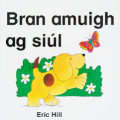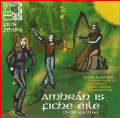
- Leabhair
- Aistriúchán
- Béaloideas & Seanfhocail
- Bearta
- Beathaisnéisí
- Bunscoil
- Ceol
- Closleabhair
- Dátheangach
- Drámaíocht
- Ficsean
Leabhar na Míosa - Páistí
- Ceol
Dlúthdhiosca na Míosa
- Cluichí
An-spraíúil!
- Acmhainní do Mhúinteoirí
Acmhainn iontach
- ClubLeabhar.com
- ClubLeabhar.com
- Earrach 2012
- Earrach 2013
- Earrach 2014
- Earrach 2015
- Earrach 2016
- Earrach 2017
- Earrach 2018
- Earrach 2019
- Earrach 2020
Leabhar na Míosa - Mí an Mheithimh 2021
- Baile
- Séamas Mac Annaidh
Rugadh Séamas Mac Annaidh i mBaile Átha Cliath sa bhliain 1961, an duine ba shine den cheathrar clainne a bhí ar a athair (bainisteoir bainc as Tír Eoghain) agus a mháthair an Dr. Ita Briscoe. Bhí cónaí air in áiteanna éagsúla: Muineachán 1961-1964; Dún Dealgan 1964-1966; Inis Ceithleann 1966-1993 agus i nDoire ó 1993 i Leith. Conaíonn sé lena bhean Joy Beatty, a rugadh i Latharna agus a n-iníon Raphaelle, a rugadh in 2001. Ghnóthaigh sé bunchéim sa Ghaeilge agus sa Bhéarla ó Ollscoil Uladh, Cúil Raithin i 1982. Chaith sé ceithre bliana ag obair mar chúntóir leabharlainne in Inis Ceithleann ó 1984 go dtí 1988, agus mar scríbhneoir cónaithe i Ollscoil Uladh agus in Ollscoil na Banríona ina dhiaidh sin. Tá roinnt ceirníní eisithe aige leis an ngrúpa Lonta Fhear Manach (ainm atá bunaithe ar theideal a chéad úrscéil) agus tá scannán déanta aige Misteach Bhaile Átha Cliath (1995) do RTÉ agus BBC Uladh.
Ó 1991 tá sé ag obair mar scríbhneoir/chraoltóir féinfhostaithe agus bhí sé ina eagarthóir liteartha ar LÁ go háirithe ar feadh tréimhse go dtí 2003. Cé go bhfuil blúirí scribhneoireachta cruthaithí foilsithe aige in áiteanna eagsúla, agus úrscéal le Andrea Camilleri aistrithe ón Iodáilis aige, Colún Deataigh (Coiscéim, 1999) chomh maith lena lán ábhar ar an stair áitiúil, ní cosúil go bhfuil sé i gceist aige bunúrscéal eile dá chuid féin a sholáthar go fóill. Is ar an tríológ d’úrscéalta atá scríofa aige a bhraitheann a cháil: Cuaifeach mo lon dubh buí, Mo dhá Mhicí agus Rubble na Mickies (Coiscéim, 1983, 1986 agus 1990 faoi seach) ach tá cnuasach gearrscéalta Féirín, scéalta agus eile (Coiscéim, 1992) agus úrscéal i bhfoirm dialainne An deireadh (Coiscéim, 1996) scríofa aige chomh maith.
Tugadh ardmholadh don chéad leabhar den tríológ nuair a foilsíodh é agus níorbh fheadair éinne an raibh tríológ beartaithe i ndáiríre nó an amhlaidh go raibh an t-údar ag magadh faoina chuid léitheoirí mar bhí féith an ghrinn (agus an fhéin-chomhfheasa) le brath go láidir san úrscéal. Is deacair cur síos go gairid ar phlota Cuaifeach mo lon dubh buí, ach tá stíl dá chuid féin aige agus atmaisféar osréalaíoch dá réir. Tá na príomhcharachtair sna déaga nó sna fichidí luatha agus léirítear an-tuiscint orthu agus an-mhacántacht. Is í féiniúlacht an duine aonair an príomhthéama atá ag an úrscéal neamhghnách seo. Díol suntais dá lán daoine ba ea an méid Béarla atá sa leabhar, ach úsáidtear an dá theanga ar bhealach an-chliste chun fíricí áirithe sochtheangeolaíocha a chur abhaile ar an léitheoir, rud a bhaineann go dlúth le téamaí an leabhair. Sa chuid lárnach den scéal is féidir a áiteamh gur bildungsroman é Cuaifeach mo londubh buí (agus an dá leabhar eile sa tríológ), nó léiriú ar aigne ann féin - ar nós Tristam Shandy sa Bhéarla le Laurence Sterne. In ainneoin go bhfuil Mo dhá Mhicí agus Rubble na Mickies ar ardchaighdeán chomh maith, cuimhnítear go háirithe ar Cuaifeach mo lon dubh buí, toisc a spleodraí agus a éagsúla is a bhí sé. Tá an-chuid léirmheastóireachta déanta ar Cuaifeach mo lon dubh buí ach is fiú go háirithe Séamas Mac Annaidh agus Macallaí Sa Scáthán (Cois Life, 2001) le Maolmhaodhóg Ó Ruairc a léamh chun pictiúr dá shaothar iomlán a fháil. Foilsíodh an cnuasach gearrscéalta is déanaí leis Mr. Lisa agus an Gramafón (Coiscéim, 2005) i 2005.
Tuilleadh ó Séamas Mac Annaidh
Cóipcheart © 2021 Gaelchultúr Teoranta
Gaelchultúr Teoranta, 11 Sráid an Chláraigh, Baile Átha Cliath 2, Éire
Uimhreacha gutháin: (01) 484 5220
Seol ríomhphost chugainn






